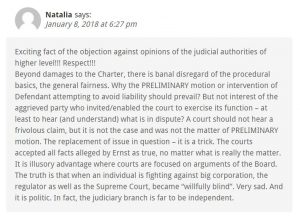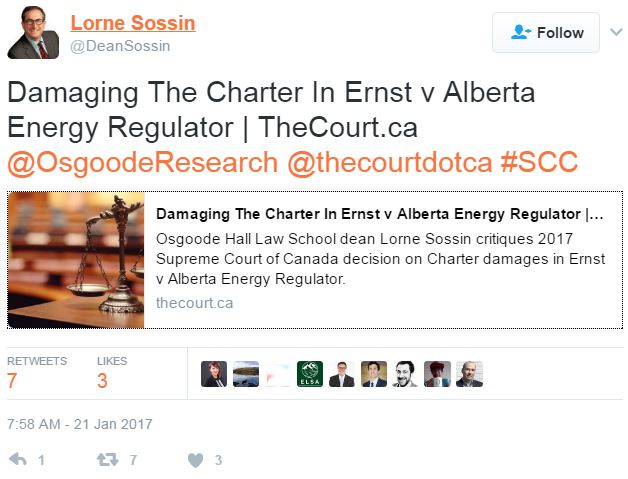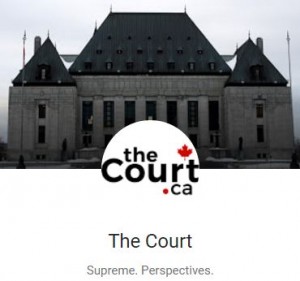It causes one to question how much both the plurality and the dissent were driven by the desired end-state of the judgment, rather than consistency in applying principles of public law.
Another thought was added a year later:

Damaging the Charter by Lorne Sossin, January 20, 2017, The Court.ca
In a fascinating, divided, and ultimately underwhelming start to 2017, the Supreme Court in Ernst v. Alberta Energy Regulator, 2017 SCC 1, grapples with the availability of Charter damages in the face of a statutory bar to civil litigation against a public regulator.
The case arises in the context of a property owner, Jessica Ernst (Ernst), who is seeking various remedies against private and public parties she believes responsible for harm to her property as a result of fracking activities. One of the defendants in her claim was the Alberta Energy Regulator (the “Board”), a statutory, quasi-independent energy regulator. Among other grounds for relief, Ernst alleged she was “punished” by the Board for publicly criticizing the Board and prevented by the Board from speaking out for a period of 16 months. Ernst claimed that her s.2(a) Charter right to freedom of expression was breached, and that Charter damages should be available to remedy that breach. As this case arises from a motion to strike her claim based on pleadings, all the facts alleged by Ernst must be accepted by the Court as true.
A provision (s.43) of the Energy Resources Conservation Act—the statute that governs the Board—immunizes the Board from civil claims for actions it takes pursuant to its statutory authority. Both the Alberta Court of Queen’s Bench and the Court of Appeal found that the immunity clause on its face bars Ernst’s claim for Charter damages and concluded therefore that her claim against the Board should be struck out. On appeal to the Supreme Court, for the first time, she added to her claim a challenge to the constitutional validity of s. 43.
The immunity clause at issue reads:
43 No action or proceeding may be brought against the Board or a member of the Board or a person referred to in section 10 or 17(1) in respect of any act or thing done purportedly in pursuance of this Act, or any Act that the Board administers, the regulations under any of those Acts or a decision, order or direction of the Board.
[Note: Section 43 has since been repealed and replaced by section 27 of the Responsible Energy Development Act, which has similar wording.]
The majority judgment (authored by Cromwell J. in presumably one of his final judgments), concludes that since Ernst herself acknowledged the statutory bar precluded her claim for Charter damages (and therefore should be struck down), and no authorities were offered in support of the view that the statutory bar did not preclude that claim, then the Supreme Court must proceed on that basis. Cromwell J. separately concluded that even if a Charter damages claim were permitted, it would fail in these circumstances because of the countervailing factors against the awarding of Charter damages as recognized in Vancouver (City) v. Ward, 2010 SCC 27.
In Ward, the Court set out a framework for the Charter damages claims under s.24(1), under which the claimant must demonstrate that her or his Charter rights have been breached and that damages would serve a compensation, vindication, or deterrence. Once that burden is met, the state has the onus to demonstrate damages should not be awarded based on countervailing considerations (such as the availability of alternative remedies and good governance arguments).
The majority’s view that it must accept the statutory bar precluding a claim to Charter damages because the claimant seems to accept this premise unduly fetters the discretion of the Court. If the proper understanding of a Charter doctrine has not been advanced by the parties, this does not mean the Court must accept an improper understanding. It is always open to the Supreme Court to reach a conclusion on a question of constitutional interpretation even if it differs from the position advanced by the parties. For reasons set out below, in my view, the premise the Court accepts in Ernst, that a statutory immunity clause can bar a Charter claim, is flawed.
The majority’s discussion of countervailing factors is also unpersuasive. The existence of countervailing factors, as set out above, only arises where a party’s entitlement to Charter damages has been established and where the Crown seeks to demonstrate that damages nonetheless should not be awarded.
First, a preliminary motion to strike Ernst’s claim against the Board because of the statutory bar to Charter damages should not depend on whether she has a strong or weak case to actually establish her entitlement to damages, nor on whether the Crown has or does not have grounds to raise countervailing factors. Either her Charter claim is barred (in which case the analysis of countervailing factors is irrelevant), or it is not barred (in which case the analysis of countervailing factors is premature).
Second, the existence of countervailing factors in this case is not compelling. The majority asserts that because judicial review is available on administrative law grounds, this alternative remedy militates against the availability of Charter damages. The effect of the majority finding is that while a common law remedy (judicial review) cannot be barred by statute, a constitutional remedy (Charter damages) can be. This finding is puzzling. Statutes must be interpreted in ways that safeguard, not inhibit, the protection of Charter rights and freedoms.
The countervailing good governance concerns also fall flat. Cromwell J. notes that the Board must be free from the anxiety of constant litigation in pursuing its statutory goals. While this might be relevant where a claim relates to someone aggrieved by the regulatory actions of a regulator, Ernst involves a regulator engaging in punitive behaviour in an attempt to silence a complainant. A suit for Charter damages is not the same as a suit for civil damages, and the Court’s desire to frame the former as a species of the latter (rather than as part of the spectrum of remedies for Charter beaches per se) leads the majority of the Court, in my view, down a problematic path.
The premise of the majority is that a Charter damages claim is akin to other civil claims for damages, and therefore precluded by the statutory bar. In reaching this conclusion, the majority relies on cases involving the high bar for negligence claims against public regulators—Cromwell J. observes, “While, as noted, Charter damages are an autonomous remedy, and every state actor has an obligation to be Charter-compliant, the same policy considerations as are present in the law of negligence nonetheless weigh heavily here…” (para. 43). The second point in this passage simply does not follow from the first. If Charter damages represent an autonomous remedy, and if every state actor has an obligation to be Charter-compliant, then the case law relating to negligence against state agencies sheds little if any light on the issue (just as the majority of the Court, in Henry v. British Columbia (Attorney General), 2015 SCC 24, held that the tort of malicious prosecution did not shed light on the test appropriate for Charter damages claims against Crown prosecutors). The search for remedies that are “just and appropriate” under s.24 of the Charter is fundamentally distinct from the search for a duty of care and breach under the common law tort of negligence.
The dissenting group of four Justices, led by Chief Justice McLachlin and Justices Moldaver and Brown JJ. (with Justice Côté concurring), conclude that Ernst’s claim should not be struck, as it was not plain and obvious that Charter damages could in no circumstances be an appropriate and just remedy in a claim against the Board. Further, they conclude it is not plain and obvious that Ernst’s claim is barred by s. 43. While I think the dissenting Justices come to the right conclusion, their reasoning is also based on a faulty premise. They write:
In deciding whether a claim for Charter damages should be struck out on the basis of a statutory immunity clause, the court must first determine whether it is plain and obvious that Charter damages could not be an appropriate and just remedy in the circumstances of the plaintiff’s claim.
By suggesting that the merits of the Charter damages have to be assessed before considering the scope of the statutory immunity clause, the dissenting Justices, like the majority, seem to put the statutory cart before the constitutional horse. It is entirely possible that Charter damages are not warranted in the circumstances of this case (though it is uncertain on what grounds the Court could reach such a determination while also accepting all the facts as pleaded by the claimant as true), but that analysis has little to do with whether a statutory bar can preclude a s.24 Charter remedy. The issue in the appeal to the Supreme Court is on the scope of the statutory immunity clause, not the strength of the claim to Charter damages.
In my view, the answer to the question regarding the statutory immunity clause raised in this case is far simpler than the approach taken by the majority or dissenting Justices. An immunity clause can preclude only those claims that a legislature has the constitutional authority to bar—that includes civil claims for damages, but it cannot bar Charter claims (including Charter claims where one of the remedies sought is Charter damages). On this reading, the Court could and should have interpreted the statutory bar as inapplicable to this claim to the extent a breach of the Charter is properly pleaded. Further, to Justice Abella’s objection in her concurring reasons, the Alberta Government would not need to have received formal notice of the claim, since the validity of the statutory immunity clause does not arise as a live issue if it is interpreted as inapplicable to Charter claims.
Returning to my broader objection with the majority of the Court’s approach to Charter damages, the claim in this case, on its face, is that a Charter breach has occurred. Ernst claims she was silenced as punishment for her opposition to the Board. The availability of Charter damages, like the availability of other Charter remedies (declarations, injunctions, etc.), cannot be precluded by an act either of a provincial legislature or of Parliament (unless the notwithstanding clause under s.33 is invoked, which is the sole mechanism for immunizing public bodies from Charter scrutiny, and therefore, from Charter remedies). Legislation can also limit the availability of Charter remedies from administrative tribunals and regulators, but here, the remedy sought is from a Court.
In my view, the Court in the Ernst case misconstrues the place of Charter damages in the context of Canada’s Constitutional architecture. In an article published almost 25 years ago on the promise and politics of Charter damages, I argued for a public rather than private law approach to damages under s.24 of the Charter (where the availability of damages would be based on Charter rather than common law duties, and where the assessment of damages would be based not on personal loss but on the gravity of the public wrong). In Ward, Henry, and now Ernst, the Court has taken a different view, seeing Charter damages primarily through a private law rather than public law lens.
It is important to recall what is at issue in Ernst. The case is not about whether the Charter was breached, or, if so, whether Charter damages are appropriate—rather, this case is about whether a claimant should have a chance to prove her allegations of a Charter breach warranting damages as a remedy, and whether a statute can bar her from having such an opportunity. In my view, by upholding the validity of a statute to bar a Charter remedy, this first judgment of 2017 has damaging potential to erode the enforcement of Charter rights. [Emphasis added]





